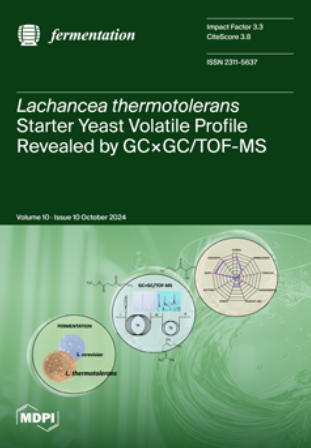裂解几丁质单加氧酶及其在几丁质资源发酵转化中的应用研究进展
IF 3.3
3区 农林科学
Q2 BIOTECHNOLOGY & APPLIED MICROBIOLOGY
引用次数: 0
摘要
全球每年产生的海产品废弃物约有1000万吨的废弃蟹、虾、龙虾壳,它们富含几丁质资源。甲壳素资源的开发利用对环境保护、经济发展和可持续发展具有重要意义。多糖单加氧酶(Lytic多糖monooxygenase, LPMOs)通过氧化破坏糖苷键催化多糖生成,对甲壳素和纤维素具有催化活性,在难降解多糖转化为生物质的过程中发挥重要作用。虽然与LPMOs相关的研究已经很多,但与裂解几丁质单加氧酶(lytic chitin monooxygenases, lcm)相关的研究仍然非常有限。lcm的具体催化机理尚未完全阐明,这给其在工业生物质转化中的应用带来了挑战。本文综述了几丁质的资源开发利用现状、几丁质不同科的来源和分类、几丁质的结构特点以及结构与功能的关系。对lcm活性检测、筛选、制备和转化等方面的研究成果进行了总结和讨论。最后,综述了lcm和几丁质酶对生物质降解的协同作用,并指出了存在的问题和未来的研究方向。本文是近年来首次对几丁质活性LPMOs进行综述,旨在为几丁质降解酶系统在工业上的应用提供参考。本文章由计算机程序翻译,如有差异,请以英文原文为准。
Research Progress of Lytic Chitin Monooxygenase and Its Utilization in Chitin Resource Fermentation Transformation
Every year, seafood waste produced globally contains about 10 million tons of wasted crab, shrimp and lobster shells, which are rich in chitin resources. The exploitation and utilization of chitin resources are of great significance to environmental protection, economic development and sustainable development. Lytic polysaccharide monooxygenases (LPMOs) can catalyze polysaccharides by oxidative breakage of glycosidic bonds and have catalytic activity for chitin and cellulose, so they play an important role in the transformation of refractory polysaccharides into biomass. Although there have been many studies related to LPMOs, the research related to lytic chitin monooxygenases (LCMs) is still very limited. The specific catalytic mechanism of LCMs has not been fully elucidated, which poses a challenge to their application in industrial biomass conversion. This review introduces the present situation of resource development and utilization in chitin, the origin and classification of different LCMs families, the structural characteristics of LCMs and the relationship between structure and function. The research results related to activity detection, screening, preparation and transformation of LCMs were summarized and discussed. Finally, the synergistic effect of LCMs and chitin enzyme on biomass degradation was reviewed, and the existing problems and future research directions were pointed out. This is the first review focusing on Chitin-Active LPMOs in recent years, intending to provide a reference for applying chitin degradation enzymes system in the industry.
求助全文
通过发布文献求助,成功后即可免费获取论文全文。
去求助
来源期刊

Fermentation-Basel
BIOTECHNOLOGY & APPLIED MICROBIOLOGY-
CiteScore
3.80
自引率
18.90%
发文量
594
审稿时长
7 weeks
期刊介绍:
Fermentation-Basel is an international open access journal published by MDPI, focusing on fermentation-related research, including new and emerging products, processes and technologies, such as biopharmaceuticals and biotech drugs. The journal enjoys a good reputation in the academic community and provides a high-impact forum for researchers in the field of bioengineering and applied microbiology.
 求助内容:
求助内容: 应助结果提醒方式:
应助结果提醒方式:


